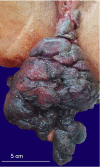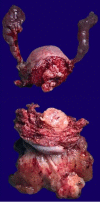Uterine cavity embryonal rhabdomyosarcoma
- PMID: 31372362
- PMCID: PMC6629268
- DOI: 10.4322/acr.2019.104
Uterine cavity embryonal rhabdomyosarcoma
Abstract
Rhabdomyosarcoma (RMS) is a rare solid tumor in childhood and adolescence. The higher incidence is predominant during the first two decades of life. According to the Intergroup RMS Study Group, the embryonal RMS (ERMS), botryoidal variant, constitutes a histological subtype characterized as a "grape-like" lesion of 2.0 cm to 9.5 cm. The treatment involves chemotherapy, surgery, and/or radiotherapy. We present the case of a 14-year-old female patient diagnosed with ERMS, botryoidal variant, which originated in the uterine cervix with vaginal externalization. The initial therapeutic approach comprised an initial prolapsed mass excision followed by Wertheim-Meigs surgery due to the tumor extension. No consensual protocol to ERMS treatment is found in the medical literature; however, a combined approach seems to offer a better result. The postoperative time period was uneventful and the patient followed an adjuvant therapy with vincristine, d-actinomycin, and cyclophosphamide. A comprehensive evaluation of the therapeutic options preserving the reproductive function-unfortunately not always possible-is part of a multi-disciplined care team concerning the pediatric patients.
Keywords: Cervix Uteri; Rhabdomyosarcoma, Embryonal; Uterine Cervical Neoplasms.
Conflict of interest statement
Conflict of interest: None
Figures






References
-
- Chintagumpala MM. Soft-tissue sarcomas In: McMillan JA, Feigin RD, DeAngelis CD, Jones MD Jr, editors. Oski’s pediatrics: principles and practice. 4th ed. Philadelphia: Williams & Wilkins; 2006. p. 1781-6.
-
- Maurer HM. The Intergroup Rhabdomyosarcoma study: update. Natl Cancer Inst Monogr. 1981;56(56):61-8. - PubMed
-
- Semczuk A, Baranowski W, Berbeć H, Marzec B, Skomra D, Miturski R. Analysis of p53 and K-ras genes and their proteins in a sarcoma botryoides of the uterine cervix. Eur J Gynaecol Oncol. 1999;20(4):311-4. - PubMed

